2006 SUBARU TRIBECA flat tire
[x] Cancel search: flat tirePage 240 of 377

Starting and operating 7-25
– CONTINUED –
NOTE
This device complies with Part 15 of
the FCC Rules and with RSS-210 of In-
dustry Canada. Operation is subject to
the following two conditions: (1) This
device may not cause harmful interfer-
ence, and (2) this device must accept
any interference received, including in-
terference that may cause undesired
operation.
Changes or modifications not express-
ly approved by the party responsible
for compliance could void the user’s
authority to operate the equipment.
Parking your vehicleIf this light still comes on while driv-
ing after adjusting the tire pressure,
a tire may have significant damage
and a fast leak that causes the tire to
lose air rapidly. If you have a flat tire,
replace it with a spare tire as soon
as possible. When a spare tire is
mounted or a wheel rim is replaced
without the original pressure sen-
sor/transmitter being transferred,
the low tire pressure warning light
will flash. This indicates the TPMS is unable to monitor all four road
wheels. Contact your SUBARU deal-
er as soon as possible for tire and
sensor replacement and/or system resetting.
Do not inject any tire liquid or aero-
sol tire sealant into the tires, as this
may cause a malfunction of the tire
pressure sensors. If the light flash-
es, promptly contact a SUBARU
dealer to have the system inspect-
ed.
Do not place metal film or any metal
parts under the driver’s seat. This
may cause poor reception of the sig-
nals from the tire pressure sensors,
and the tire pressure monitoring
system will not function properly.
�yNever leave unattended children
or pets in the vehicle. They could
accidentally injure themselves or
others through inadvertent opera-
tion of the vehicle. Also, on hot or
sunny days, the temperature in a
closed vehicle could quickly be-
come high enough to cause se-
vere or possibly fatal injuries to them.
�yDo not park the vehicle over flam-
mable materials such as dry
grass, waste paper or rags, as
they may burn easily if they come
near hot engine or exhaust sys-
tem parts.
�yBe sure to stop the engine if you
take a nap in the vehicle. If engine
exhaust gas enters the passenger
compartment, occupants in the
vehicle could die from carbon
monoxide (CO) contained in the
exhaust gas.
Page 247 of 377
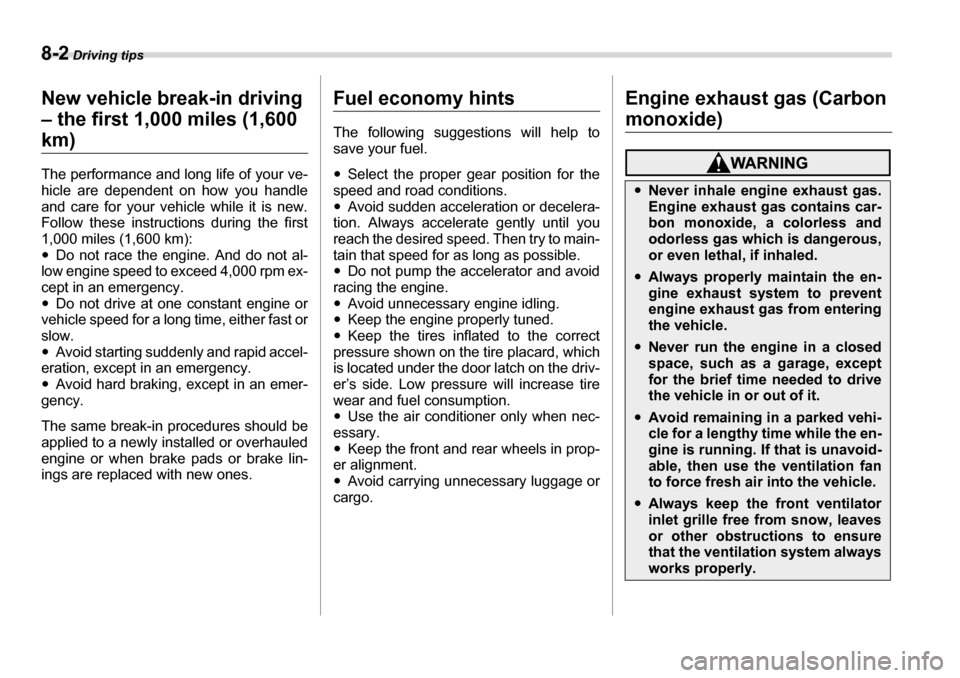
8-2 Driving tips
Driving tipsNew vehicle break-in driving – the first 1,000 miles (1,600
km)
The performance and long life of your ve-
hicle are dependent on how you handle
and care for your vehicle while it is new.
Follow these instructions during the first
1,000 miles (1,600 km):�yDo not race the engine. And do not al-
low engine speed to exceed 4,000 rpm ex-
cept in an emergency.�y Do not drive at one constant engine or
vehicle speed for a long time, either fast orslow.�y Avoid starting suddenly and rapid accel-
eration, except in an emergency.�y Avoid hard braking, except in an emer-
gency.
The same break-in procedures should be
applied to a newly installed or overhauled
engine or when brake pads or brake lin-
ings are replaced with new ones.
Fuel economy hints
The following suggestions will help to save your fuel. �y Select the proper gear position for the
speed and road conditions. �y Avoid sudden acceleration or decelera-
tion. Always accelerate gently until you
reach the desired speed. Then try to main-
tain that speed for as long as possible. �y Do not pump the accelerator and avoid
racing the engine. �y Avoid unnecessary engine idling.
�y Keep the engine properly tuned.
�y Keep the tires inflated to the correct
pressure shown on the tire placard, which
is located under the door latch on the driv-
er’s side. Low pressure will increase tire
wear and fuel consumption. �y Use the air conditioner only when nec-
essary. �y Keep the front and rear wheels in prop-
er alignment.�y Avoid carrying unnecessary luggage or
cargo. Engine exhaust gas (Carbon
monoxide)
�y
Never inhale engine exhaust gas.
Engine exhaust gas contains car-
bon monoxide, a colorless and
odorless gas which is dangerous,
or even lethal, if inhaled.
�yAlways properly maintain the en-
gine exhaust system to prevent
engine exhaust gas from entering
the vehicle.
�yNever run the engine in a closed
space, such as a garage, except
for the brief time needed to drive
the vehicle in or out of it.
�yAvoid remaining in a parked vehi-
cle for a lengthy time while the en-
gine is running. If that is unavoid-able, then use the ventilation fan
to force fresh air into the vehicle.
�yAlways keep the front ventilator
inlet grille free from snow, leaves
or other obstructions to ensure
that the ventilation system always
works properly.
Page 250 of 377
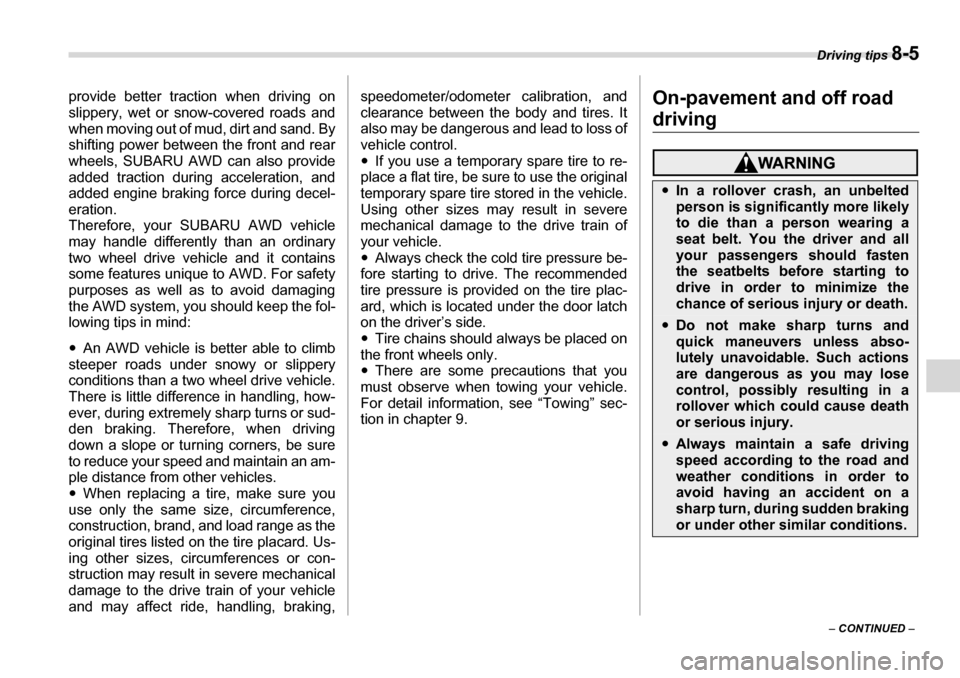
Driving tips 8-5
– CONTINUED –
provide better traction when driving on
slippery, wet or snow-covered roads and
when moving out of mud, dirt and sand. By
shifting power between the front and rear
wheels, SUBARU AWD can also provide
added traction during acceleration, and
added engine braking force during decel-
eration.
Therefore, your SUBARU AWD vehicle
may handle differently than an ordinary
two wheel drive vehicle and it contains
some features unique to AWD. For safety
purposes as well as to avoid damaging
the AWD system, you should keep the fol-
lowing tips in mind: �y
An AWD vehicle is better able to climb
steeper roads under snowy or slippery
conditions than a two wheel drive vehicle.
There is little difference in handling, how-
ever, during extremely sharp turns or sud-
den braking. Therefore, when driving
down a slope or turning corners, be sure
to reduce your speed and maintain an am-
ple distance from other vehicles. �y When replacing a tire, make sure you
use only the same size, circumference,
construction, brand, and load range as the
original tires listed on the tire placard. Us-
ing other sizes, circumferences or con- struction may result in severe mechanical
damage to the drive train of your vehicle
and may affect ride, handling, braking, speedometer/odometer calibration, and
clearance between the body and tires. It
also may be dangerous and lead to loss ofvehicle control. �y
If you use a temporary spare tire to re-
place a flat tire, be sure to use the original
temporary spare tire stored in the vehicle.
Using other sizes may result in severe
mechanical damage to the drive train ofyour vehicle. �y Always check the cold tire pressure be-
fore starting to drive. The recommended
tire pressure is provided on the tire plac-
ard, which is located under the door latch
on the driver’s side.�y Tire chains should always be placed on
the front wheels only.�y There are some precautions that you
must observe when towing your vehicle.
For detail information, see “Towing” sec-
tion in chapter 9. On-pavement and off road
driving
�y
In a rollover crash, an unbelted
person is significantly more likely
to die than a person wearing a
seat belt. You the driver and all
your passengers should fasten
the seatbelts before starting to
drive in order to minimize the
chance of serious injury or death.
�yDo not make sharp turns and
quick maneuvers unless abso-
lutely unavoidable. Such actions
are dangerous as you may lose
control, possibly resulting in a
rollover which could cause death
or serious injury.
�yAlways maintain a safe driving
speed according to the road and
weather conditions in order to
avoid having an accident on a
sharp turn, during sudden braking
or under other similar conditions.
Page 251 of 377
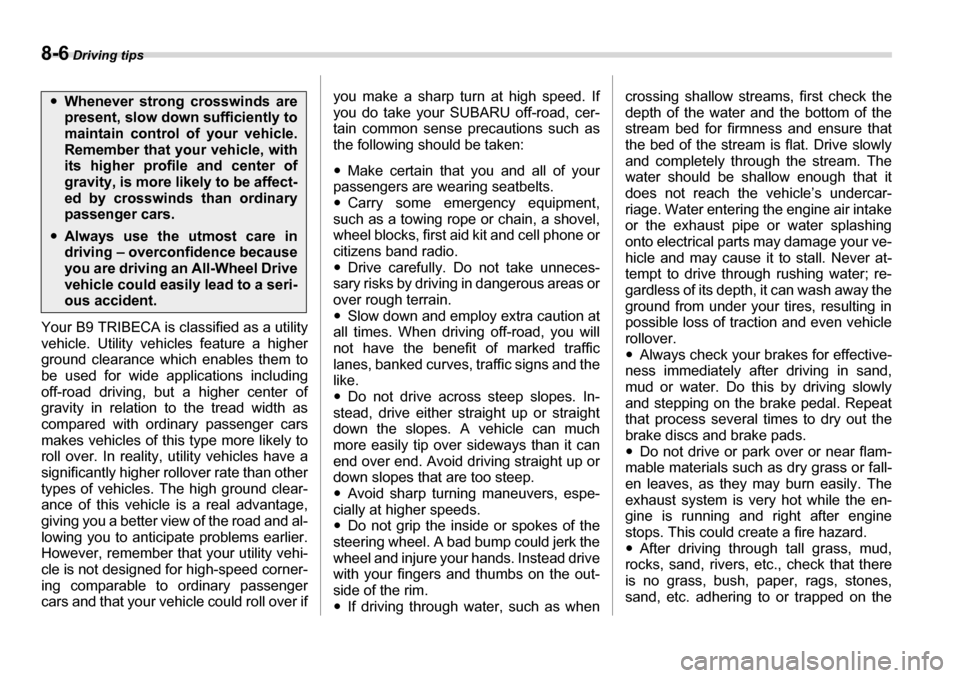
8-6 Driving tips
Your B9 TRIBECA is classified as a utility
vehicle. Utility vehicles feature a higher
ground clearance which enables them to
be used for wide applications including
off-road driving, but a higher center of
gravity in relation to the tread width as
compared with ordinary passenger cars
makes vehicles of this type more likely to
roll over. In reality, utility vehicles have a
significantly higher rollover rate than other
types of vehicles. The high ground clear-
ance of this vehicle is a real advantage,
giving you a better view of the road and al-
lowing you to anticipate problems earlier.
However, remember that your utility vehi-
cle is not designed for high-speed corner-
ing comparable to ordinary passenger
cars and that your vehicle could roll over if you make a sharp turn at high speed. If
you do take your SUBARU off-road, cer-
tain common sense precautions such as
the following should be taken: �y
Make certain that you and all of your
passengers are wearing seatbelts. �y Carry some emergency equipment,
such as a towing rope or chain, a shovel,
wheel blocks, first aid kit and cell phone or
citizens band radio. �y Drive carefully. Do not take unneces-
sary risks by driving in dangerous areas or
over rough terrain. �y Slow down and employ extra caution at
all times. When driving off-road, you will
not have the benefit of marked traffic
lanes, banked curves, traffic signs and the
like. �y Do not drive across steep slopes. In-
stead, drive either straight up or straight
down the slopes. A vehicle can much
more easily tip over sideways than it can
end over end. Avoid driving straight up or
down slopes that are too steep. �y Avoid sharp turning maneuvers, espe-
cially at higher speeds. �y Do not grip the inside or spokes of the
steering wheel. A bad bump could jerk the
wheel and injure your hands. Instead drive
with your fingers and thumbs on the out-
side of the rim.�y If driving through water, such as when crossing shallow streams, first check the
depth of the water and the bottom of the
stream bed for firmness and ensure that
the bed of the stream is flat. Drive slowly
and completely through the stream. The
water should be shallow enough that it
does not reach the vehicle’s undercar-
riage. Water entering the engine air intake
or the exhaust pipe or water splashing
onto electrical parts may damage your ve-
hicle and may cause it to stall. Never at-
tempt to drive through rushing water; re-
gardless of its depth, it can wash away the
ground from under your tires, resulting in
possible loss of traction and even vehiclerollover. �y
Always check your brakes for effective-
ness immediately after driving in sand,
mud or water. Do this by driving slowly
and stepping on the brake pedal. Repeat
that process several times to dry out the
brake discs and brake pads.�y Do not drive or park over or near flam-
mable materials such as dry grass or fall-
en leaves, as they may burn easily. Theexhaust system is very hot while the en-
gine is running and right after engine
stops. This could create a fire hazard.�y After driving through tall grass, mud,
rocks, sand, rivers, etc., check that there
is no grass, bush, paper, rags, stones,
sand, etc. adhering to or trapped on the
�y Whenever strong crosswinds are
present, slow down sufficiently to
maintain control of your vehicle.
Remember that your vehicle, with
its higher profile and center of
gravity, is more likely to be affect-
ed by crosswinds than ordinary
passenger cars.
�yAlways use the utmost care in
driving – overconfidence because
you are driving an All-Wheel Drive
vehicle could easily lead to a seri-
ous accident.
Page 268 of 377
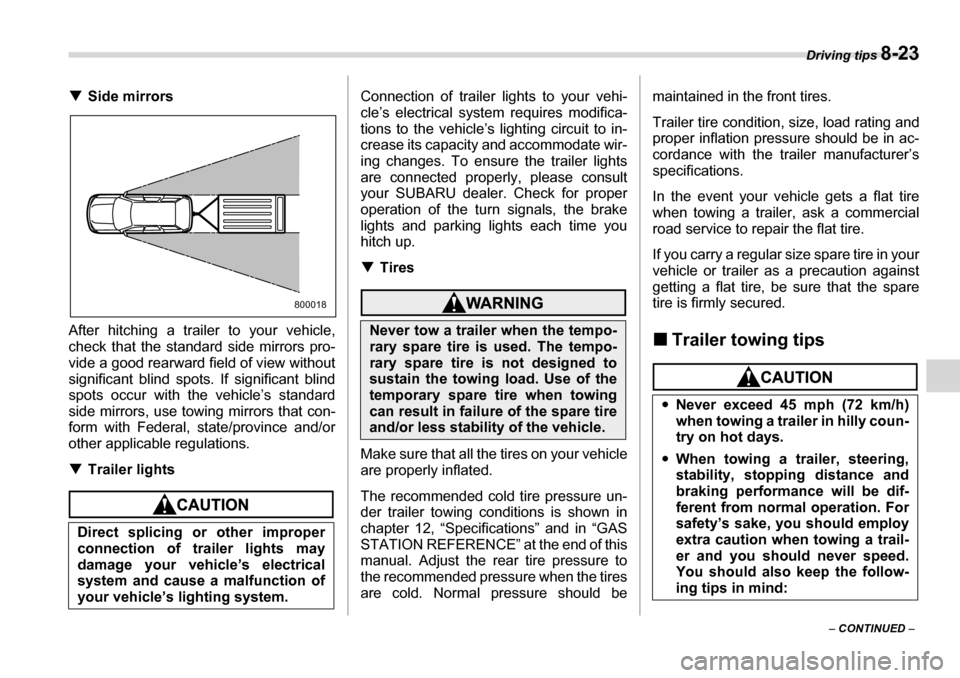
Driving tips 8-23
– CONTINUED –
�T
Side mirrors
After hitching a trailer to your vehicle,
check that the standard side mirrors pro-
vide a good rearward field of view without
significant blind spots. If significant blind
spots occur with the vehicle’s standard
side mirrors, use towing mirrors that con-
form with Federal, state/province and/or
other applicable regulations. �T Trailer lights
Connection of trailer lights to your vehi-
cle’s electrical system requires modifica-
tions to the vehicle’s lighting circuit to in-
crease its capacity and accommodate wir-
ing changes. To ensure the trailer lights
are connected properly, please consult
your SUBARU dealer. Check for proper
operation of the turn signals, the brake
lights and parking lights each time you
hitch up. �TTires
Make sure that all the tires on your vehicle
are properly inflated.
The recommended cold tire pressure un-
der trailer towing conditions is shown in
chapter 12, “Specifications” and in “GAS
STATION REFERENCE” at the end of this
manual. Adjust the rear tire pressure to
the recommended pressure when the tires
are cold. Normal pressure should be maintained in the front tires.
Trailer tire condition, size, load rating and
proper inflation pressure should be in ac-
cordance with the trailer manufacturer’s
specifications.
In the event your vehicle gets a flat tire
when towing a trailer, ask a commercial
road service to repair the flat tire.
If you carry a regular size spare tire in your
vehicle or trailer as a precaution against
getting a flat tire, be sure that the spare
tire is firmly secured. �„
Trailer towing tips
Direct splicing or other improper
connection of trailer lights may
damage your vehicle’s electrical
system and cause a malfunction of
your vehicle’s lighting system.
800018
Never tow a trailer when the tempo-
rary spare tire is used. The tempo-
rary spare tire is not designed to
sustain the towing load. Use of the
temporary spare tire when towing
can result in failure of the spare tire
and/or less stability of the vehicle.
�yNever exceed 45 mph (72 km/h)
when towing a trailer in hilly coun-
try on hot days.
�y When towing a trailer, steering,
stability, stopping distance and
braking performance will be dif-
ferent from normal operation. For
safety’s sake, you should employ
extra caution when towing a trail-
er and you should never speed.
You should also keep the follow-
ing tips in mind:
Page 272 of 377
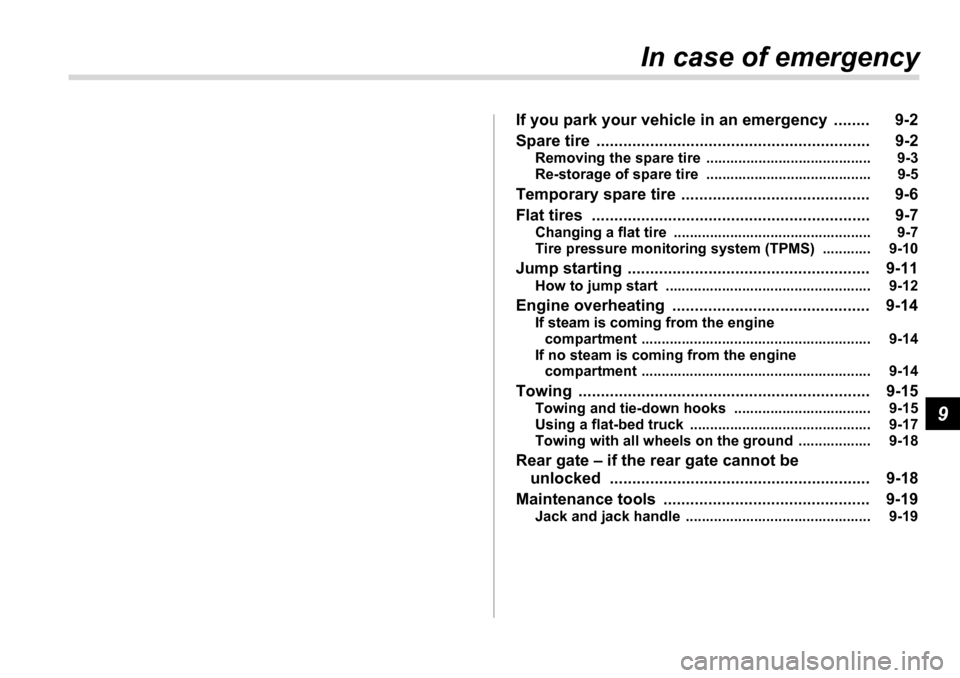
9
In case of emergency
If you park your vehicle in an emergency ........ 9-2
Spare tire ............................................................. 9-2 Removing the spare tire ......................................... 9-3
Re-storage of spare tire ......................................... 9-5
Temporary spare tire .......................................... 9-6
Flat tires .............................................................. 9-7 Changing a flat tire ................................................. 9-7
Tire pressure monitoring system (TPMS) ............ 9-10
Jump starting ...................................................... 9-11 How to jump start ................................................... 9-12
Engine overheating ............................................ 9-14 If steam is coming from the engine compartment ......................................................... 9-14
If no steam is coming from the engine
compartment ......................................................... 9-14
Towing ................................................................. 9-15 Towing and tie-down hooks .................................. 9-15
Using a flat-bed truck ............................................. 9-17
Towing with all wheels on the ground .................. 9-18
Rear gate – if the rear gate cannot be unlocked .......................................................... 9-18
Maintenance tools .............................................. 9-19 Jack and jack handle .............................................. 9-19
Page 273 of 377
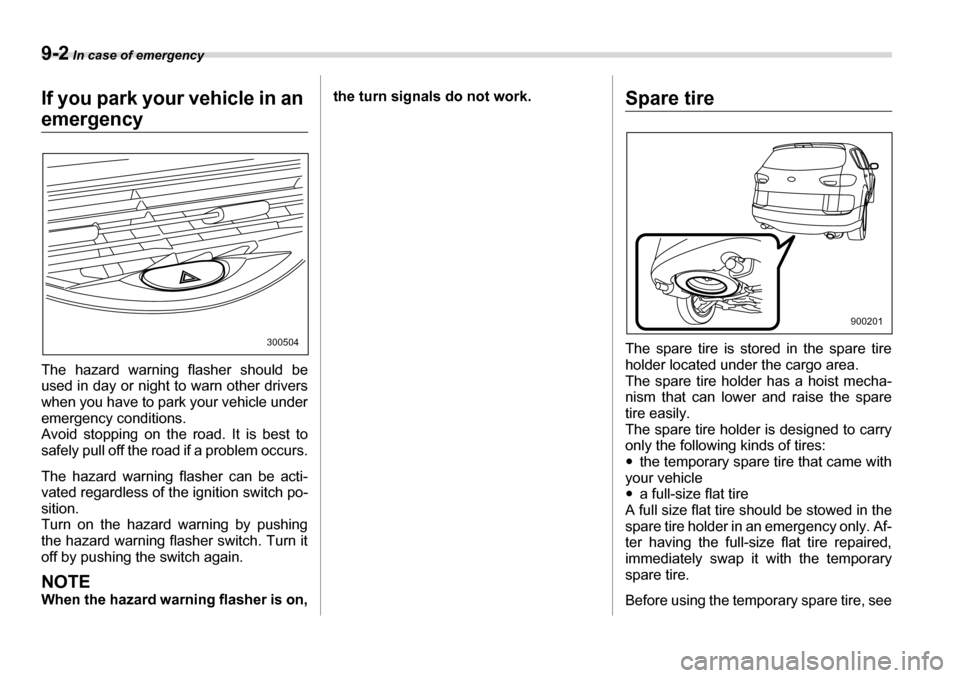
9-2 In case of emergency
In case of emergencyIf you park your vehicle in an
emergency
The hazard warning flasher should be
used in day or night to warn other drivers
when you have to park your vehicle under
emergency conditions.
Avoid stopping on the road. It is best to
safely pull off the road if a problem occurs.
The hazard warning flasher can be acti-
vated regardless of the ignition switch po- sition.
Turn on the hazard warning by pushing
the hazard warning flasher switch. Turn it
off by pushing the switch again.
NOTE
When the hazard warning flasher is on, the turn signals do not work.
Spare tire
The spare tire is stored in the spare tire
holder located under the cargo area.
The spare tire holder has a hoist mecha-
nism that can lower and raise the spare
tire easily.
The spare tire holder is designed to carry
only the following kinds of tires: �y
the temporary spare tire that came with
your vehicle �y a full-size flat tire
A full size flat tire should be stowed in the
spare tire holder in an emergency only. Af-
ter having the full-size flat tire repaired,
immediately swap it with the temporaryspare tire.
Before using the temporary spare tire, see
300504
900201
Page 275 of 377
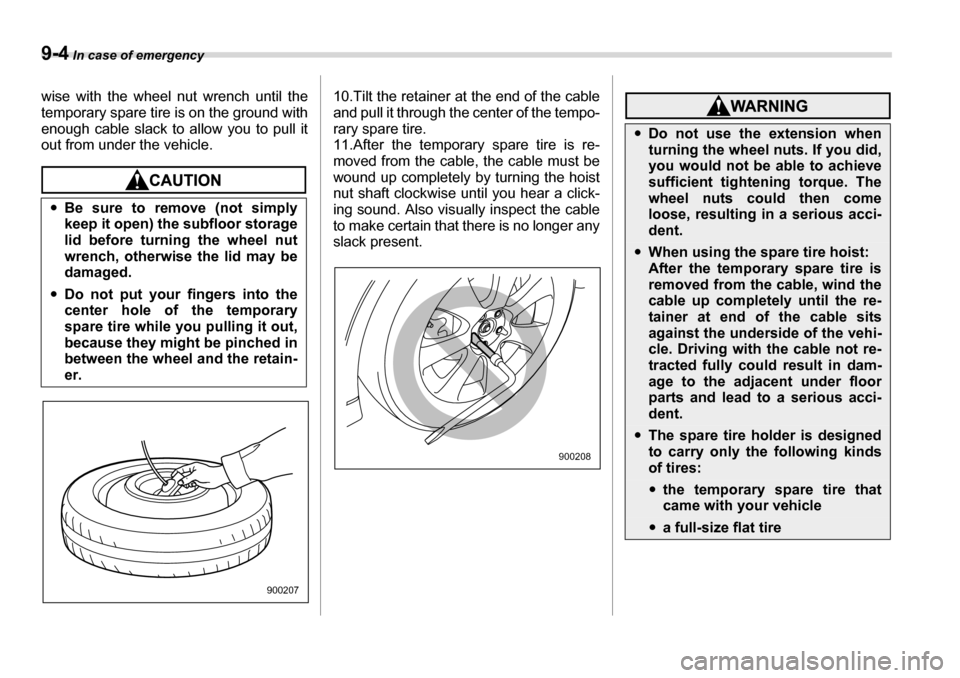
9-4 In case of emergency
wise with the wheel nut wrench until the
temporary spare tire is on the ground with
enough cable slack to allow you to pull it
out from under the vehicle.10.Tilt the retainer at the end of the cable
and pull it through the center of the tempo-
rary spare tire.
11.After the temporary spare tire is re-
moved from the cable, the cable must be
wound up completely by turning the hoist
nut shaft clockwise until you hear a click-
ing sound. Also visually inspect the cable
to make certain that there is no longer any
slack present.
�yBe sure to remove (not simply
keep it open) the subfloor storage
lid before turning the wheel nut
wrench, otherwise the lid may be
damaged.
�y Do not put your fingers into the
center hole of the temporary
spare tire while you pulling it out,
because they might be pinched in
between the wheel and the retain-er.
900207
900208
�yDo not use the extension when
turning the wheel nuts. If you did,
you would not be able to achieve sufficient tightening torque. The
wheel nuts could then come
loose, resulting in a serious acci-
dent.
�yWhen using the spare tire hoist:
After the temporary spare tire is
removed from the cable, wind the
cable up completely until the re-
tainer at end of the cable sits
against the underside of the vehi-
cle. Driving with the cable not re-
tracted fully could result in dam-
age to the adjacent under floor
parts and lead to a serious acci-
dent.
�yThe spare tire holder is designed to carry only the following kinds
of tires:
�ythe temporary spare tire that
came with your vehicle
�ya full-size flat tire